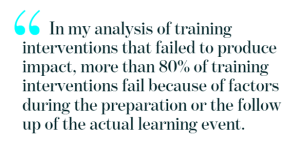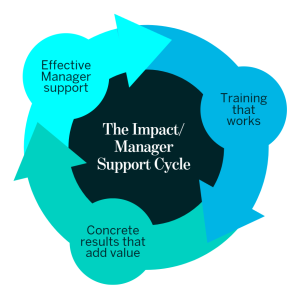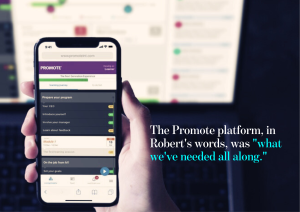At a recent HPConnect networking lunch, we were joined for a virtual fireside chat by Professor Robert Brinkerhoff, an internationally recognised expert in learning effectiveness and evaluation. Joining us by Zoom from his home in the United States, Robert talked to HPC’s Kevin Hannigan about how organisations can increase learning transfer and impact.
Learning Transfer – what is it and what drives it?
Kevin and Robert began their long-distance conversation by talking about what exactly the term “Learning Transfer” means. While Robert shared the widely used definition of learning transfer as ‘the application of learning in the workplace’, he suggested this definition was not quite complete. Robert shared an anecdote about a person who attended a programme on developing financial acumen. After the programme, the person managed to apply the learning very successfully in his local church group but stated that he couldn’t apply the learning at work due to the obstacle of securing a host of approvals. Such a learning event generated inconsequential to no value to the sponsor of the learning. Learning Transfer occurs when we use training to generate “consequential value” for the organisation. In the work setting, learning is not just about absorbing knowledge but must involve using that knowledge in a way that delivers value back to the organisation.
Brinkerhoff suggests that our aim should be to seek “leveraged transfer” – applying learning in those actions and instances where use of the training will have the greatest payoff. He went on to note that these leverage-transfer opportunities will differ for each trainee, according to their particular job context, and so part of our training designs must included tactics to help trainees identify what their own leveraged transfer opportunities will be.
 Kevin then asked Robert about what drives learning transfer. In Robert’s view, many factors drive learning transfer, some of which happen before the learning takes place, and some of which take place after the learning. In Robert’s experience, about 80% of the impact of learning depends on these before and after elements. Some specific considerations that Robert highlighted are:
Kevin then asked Robert about what drives learning transfer. In Robert’s view, many factors drive learning transfer, some of which happen before the learning takes place, and some of which take place after the learning. In Robert’s experience, about 80% of the impact of learning depends on these before and after elements. Some specific considerations that Robert highlighted are:
– Does the learner’s manager know what the training is intended to do?
– Does the learner know why they are participating in the training?
– Are the objectives of the training aligned with the person’s work?
– Is there intent to apply the training in the work environment?
– Does the learner see a way in which the learning can be used?
– Will the learner have the space and time to apply their learning?
– What expectations does the learner have of receiving coaching and feedback as they apply their learning
Line manager involvement is key
 Kevin noted how these elements suggest that the involvement and support of the learner’s line manager is key, and probed Robert a little more on this. Robert emphasised that the manager is key to the learner developing a sense of accountability for applying their learning and that this, in turn, depends on there being a dialogue with the manager before and after the learning. Robert noted how often “most people are held accountable for participating” but that this is not enough for learning to deliver real and consequential value to the organisation.
Kevin noted how these elements suggest that the involvement and support of the learner’s line manager is key, and probed Robert a little more on this. Robert emphasised that the manager is key to the learner developing a sense of accountability for applying their learning and that this, in turn, depends on there being a dialogue with the manager before and after the learning. Robert noted how often “most people are held accountable for participating” but that this is not enough for learning to deliver real and consequential value to the organisation.
The conversation then moved to talk about the importance of generating more engagement from these same managers, with Robert noting that managers can easily undo the benefits of training if they are not careful. Robert shared an anecdote about his time in the US Navy, highlighting how a very positive experience attending a training programme in Washington D.C. was undone in mere moments by a dismissive comment from his superior officer upon Robert’s arrival back at his home base.
Kevin asked why L&D professionals often struggle to secure the engagement and involvement of learners’ managers, and Robert highlighted how L&D professionals sometimes approach such managers in a “supplicant” manner, essentially saying “I need your help…” This respectful tone of request conveys a submissive positioning of L&D and Robert suggested instead that a more appropriate approach would be as a business partner presenting the business value as the reason for the training. When a manager can’t see what benefit the training will yield for them it’s too easy for them to dismiss it.
In another anecdote, Robert noted how a senior leader at a major financial institution responded when asked “Tell me what you expected from the training”. “Not a damn thing, which is exactly what I got. As far as I’m concerned, the quicker it’s over the better,” was their response.
Managers and leaders need evidence about learning’s value, In Brinkerhoff’s view, much impact is lost because of what he calls the “manager self-fulfilling prophecy cycle” that occurs. That is, managers have not been shown explicitly how some training may help them increase their employee’s performance, thus helping them as managers improve their own KPIs. Lacking this awareness, they expect little from the training, and thus do not support it. This lack of support limits or even negates the impact, so the managers’ expectations are indeed fulfilled. “See?” they tell themselves, “I did not waste time supporting training that I didn’t expect results from, and I was right! There were no results” As L&D leaders, we have to try to reverse that negative cycle. Help managers see and expect the value the training can produce for them, help them see how to support it, then show them the evidence that training (when it is supported) does indeed produce value. If we as L&D leaders cannot make a case that the training will add value and produce impact and tell that story explicitly, then we have no business asking managers to support it.
Robert went on to share an example where he was able to supply data on how a programme generated a 42% increase in sales for those learners who attended the programme when they and their managers had engaged in dialogue about what to expect by way of applying the learning before and after the programme. There was also evidence that learners who did not have this before-and-after dialogue did not experience these strongly positive results. When the sponsors of his programme saw the evidence, they took aggressive steps to require managers (and in turn the managers of those managers) to be accountable for engaging in this support behaviour. These results continued to grow as more learners all discussed with their respective managers what they’d learn, how they’ll use that learning, and what their manager’s expectations of them were. In Robert’s summation words, “Where there’s evidence, you’ll get interest.”

The Promote® Platform
 The final part of the discussion explored the value of the Promote platform. HPC uses Promote to facilitate learning transfer for clients and to create a compelling blended experience for programme participants. Since starting to use the platform in 2016, it has supported thousands of learners to continue their learning journey beyond the “classroom”. Kevin first came across the Promote platform when reading a report that Robert had joined the company as an advisor and he was curious as to how Robert had become involved. Robert first encountered the platform after he had retired, noting that for most of his career training was event-focused. Robert knew of the importance of the before and after factors that wrap around a training event, as well as the reliance on managers, all of which was hard to do. The Promote platform, in Robert’s words, was “what we’ve needed all along! When I saw it, I came off the retirement bench to get involved as much as I could in this promising technology!” The platform allows you to manage the before and after factors, giving you control and allowing you to connect with your learners in their workplace. Equally, there is no place to hide for a learner anymore because we can see it and do something about it. With Promote, learners are accountable for doing something useful with their learning.
The final part of the discussion explored the value of the Promote platform. HPC uses Promote to facilitate learning transfer for clients and to create a compelling blended experience for programme participants. Since starting to use the platform in 2016, it has supported thousands of learners to continue their learning journey beyond the “classroom”. Kevin first came across the Promote platform when reading a report that Robert had joined the company as an advisor and he was curious as to how Robert had become involved. Robert first encountered the platform after he had retired, noting that for most of his career training was event-focused. Robert knew of the importance of the before and after factors that wrap around a training event, as well as the reliance on managers, all of which was hard to do. The Promote platform, in Robert’s words, was “what we’ve needed all along! When I saw it, I came off the retirement bench to get involved as much as I could in this promising technology!” The platform allows you to manage the before and after factors, giving you control and allowing you to connect with your learners in their workplace. Equally, there is no place to hide for a learner anymore because we can see it and do something about it. With Promote, learners are accountable for doing something useful with their learning.
Robert also discussed Promote’s Manager Support tool that is based on research conducted by him and Professor Kevin Ford of Michigan State University. This ground-breaking tool is designed to enhance training impact through strategic managerial support, providing a practical guide for managers to determine the right level and type of support for their teams. It is available to all Promote licensees, and Robert hopes many will give it a try.
Attendee Questions
 As Kevin and Robert wrapped up their conversation, Robert graciously took two questions from the audience. The first question to Robert was “if he felt that L&D professionals needed to become more sales and marketing-focused to sell the benefits of learning solutions to a business.” Robert emphasised the importance of L&D professionals using data to provide evidence that training pays off, and even to show when learning is not being fully utilised and how a business could get more from it. He used the term “User education” to remind us that learning doesn’t just work magically and that you need to do something with the learning to get value from it. Being able to show a manager what is working, and where there is value not being fully exploited is very impactful. He spoke about a shift in the “user” mindset about learning. Learning is no longer about filling seats but instead is concerned with making sure L&D provides value to our clients. He ended this response by urging L&D professionals to “market the bejesus out of learning to clients”.
As Kevin and Robert wrapped up their conversation, Robert graciously took two questions from the audience. The first question to Robert was “if he felt that L&D professionals needed to become more sales and marketing-focused to sell the benefits of learning solutions to a business.” Robert emphasised the importance of L&D professionals using data to provide evidence that training pays off, and even to show when learning is not being fully utilised and how a business could get more from it. He used the term “User education” to remind us that learning doesn’t just work magically and that you need to do something with the learning to get value from it. Being able to show a manager what is working, and where there is value not being fully exploited is very impactful. He spoke about a shift in the “user” mindset about learning. Learning is no longer about filling seats but instead is concerned with making sure L&D provides value to our clients. He ended this response by urging L&D professionals to “market the bejesus out of learning to clients”.
The final audience question asked how we can engage leaders of leaders in pre- and post-workshop activities. In Robert’s view, this challenge really reflects what our collective mission is moving forward. He noted that if we want to build a learning culture, we need to tell the story of learning’s value. This is a whole organisational effort and can’t just be delegated to the L&D function. When learning was successful it was because the learners and their managers all did certain things. When you don’t do those things, don’t expect positive results. Robert concluded by suggesting that managers should be held accountable for supporting the learning of those they manage.
Professor Robert Brinkerhoff

Robert is an internationally recognised expert in learning effectiveness and evaluation. For over 40 years, he has provided consultancy services to dozens of multinational organisations including the U.S. Postal Service, Apple and The World Bank. He is a sought-after keynote speaker and conference presenter and has authored several books including The Success Case Method, Telling Training’s Story and Improving Performance through Learning.
He is currently President of The Brinkerhoff Evaluation Institute and Head of Research at Promote International where he created the ‘High Performance Learning Journey’ (HPLJ) methodology. In 2018, HPC facilitators were certified as Ireland’s first HPLJ practitioners. His work powers the Promote platform – a learner-centric app that HPC utilises in client work to embed learning and instil behavioural change.
Connect with Robert on LinkedIn >>>
Find out more about the Promote Platform >>>
Kevin Hannigan – HPC

Kevin leads the Learning and Talent Consulting offering and is also a Client Director at HPC. He works with clients to develop, deliver and evaluate bespoke solutions that drive performance across their business.
He is a highly skilled consultant and facilitator with a wealth of experience in designing the systems and processes that support effective learning, measurement and talent development.
Before joining HPC in 2013, Kevin was head of learning and development for Matheson, Ireland’s largest law firm and for C&C Ireland.
kevin.hannigan@wearehpc.com
Connect with Kevin on LinkedIn >>>